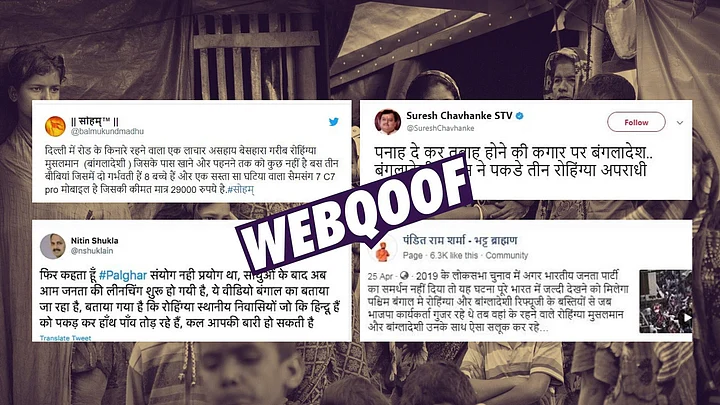With an estimated population of around 40,000 stateless Rohingya refugees living in India after fleeing from Myanmar in 2017, the fake news cycle targeting the community has refused to die down. Inflammatory posts coupled with disinformation have led to widespread anger against the community.
The year 2017 saw a deadly crackdown by Myanmar’s army on the Rohingyas – an ethnic minority in the country – resulting in large-scale migration. According to a statement by the United Nations, Facebook had a “determining role” in fueling tensions and hatred against the Rohingyas in Myanmar.
Over a span of a few years, we’ve identified multiple instances of targeted misinformation aimed at vilifying the members of this community.
How Rohingyas Become Targets of Fake News
We have been able to identify three broad categories of misinformation and fake news that have been targeting the Rohingya refugee community.
Messages aimed at fanning communal sentiments
Child-lifting rumours
Accusations of theft, murder, robbery, cow slaughter etc
Earlier In May this year, as the world was grappling with the coronavirus crisis, India saw a surge in fake news targeting a certain minority community. Around the same time, a video showing a group of men brutally beating up two others, went viral on social media with the claim that Rohingya Muslims in West Bengal were assaulting Hindus.
While many users who shared this video attempted to warn others by saying that “anybody could come under such attacks anytime now,” we found that the claim is fake and the video, in fact, is from Bangladesh where a person was allegedly beaten by a mob on charges of an auto-theft in March 2019.
Rohingyas have also been targeted with child-lifting rumours. In the summer of 2019, when child-lifting rumours were rife, multiple messages claiming that ‘2000 Rohingyas are out to kidnap children’ were widely circulated on WhatsApp.
But these, too, were unrelated and the claims had no connection with Rohingyas whatsoever.
Rohingyas have also been falsely targeted for crimes like theft, murder and heckling. For instance, in May 2019, a video of a local mob attacking volunteers at a political rally was shared with a false claim that it shows Rohingyas attacking the central forces in Bengal.
In another instance, a video claiming to show mass killings and public sale of human body parts was being shared on social media and WhatsApp with a false claim that Rohingya Muslims were killing and eating Hindus.
These instances of misinformation could be traced back to the year 2017, when Sudarshan TV, a Hindi television news channel notorious for peddling disinformation, used the photo of a disabled man being dragged by a Bangladeshi police officer, alleging that the man was a Rohingya criminal being dragged by cops.
However, the photo was actually that of an activist, and member of Gonojagoron Mancha, clicked during a protest in 2014.
What Makes Rohingyas Easy Targets For Misinformation Campaigns?
To understand what makes the Rohingya community vulnerable to targeted misinformation on social media platforms we reached out to Nandini Sundar, professor of sociology at the Delhi School of Economics (DSE) and Ritvvij Parrikh, ICFJ Knight Fellow and the co-founder of Delhi-based media development startup PROTO.
Parrikh told us that when individuals strongly identify with an ideology, they are highly susceptible to misinformation on topics impacted by that ideology.
“The ideological bias works regardless of whether the individuals are for or against a particular topic. This susceptibility increases when the piece of misinformation is aligned with their beliefs.”Ritvvij Parrikh - ICFJ Knight Fellow
Building on the argument provided by Ritvvij, the plausible reason behind people falling prey to rumours around Rohingya refugees without any critical reasoning could be because of a pre-existing bias around the community.
According to Nandini Sundar, who has worked extensively in the areas of citizenship and politics in South Asia, “the main reason behind the disinformation campaign against the Rohingyas is because they are Muslims.”
“Muslims are increasingly becoming victims of fake news and disinformation in India. The fact that they come through Bangladesh and very few people know of the history of Myanmar and how the Rohingyas were attacked adds to the problem.”Nandini Sundar, Professor of Sociology at Delhi University
A similar pattern was observed when a study conducted by four researchers in April showed how Muslims became targets of fake news in India as coronavirus spread across the country.
What Is Being Done To Tackle Such Targeted Misinformation On Social Media?
Over the years tech giants like Facebook, Google and WhatsApp have come up with several policies to prevent the spread of misinformation on their platforms and we saw the birth of fact-checking organisations across the globe to fight fake news and disinformation.
"Fact-checking initiatives publish verification reports. These reports debunk (the misinformation), but do not necessarily de-bias people from their beliefs," says Ritvvij Parrikh.
According to Parrikh, there is a need for more scalable and effective solutions to address misinformation at a cognitive level. “Most fact-checking works at the level of information (countering falsehoods with correct information). However, that takes time and effort. A more scalable and effective solution would be to address misinformation at the cognitive level,” he said.
Since 2017, more than 6,00,000 Rohingyas have fled Myanmar. According to the United Nations, Rohingyas - a predominantly Muslim minority are escaping “genocidal violence that follows decades of persecution and human rights abuses.”
And with unrelated videos, photos and messages being used to push anti-Rohingya rhetoric on social media, misinformation and fake news rest at the heart of the crisis.
(You can read all our coronavirus related fact-checked stories here.)
(Not convinced of a post or information you came across online and want it verified? Send us the details on Whatsapp at 9643651818, or e-mail it to us at webqoof@thequint.com and we'll fact-check it for you. You can also read all our fact-checked stories here.)
(At The Quint, we question everything. Play an active role in shaping our journalism by becoming a member today.)
